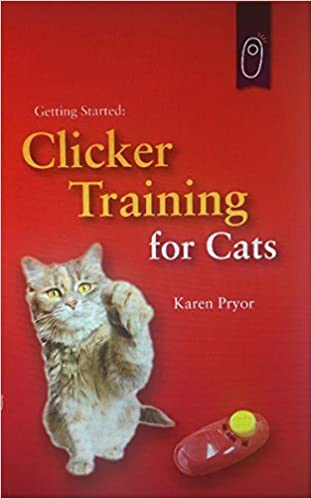Everyone knows herding cats is impossible (even Myth Busters proved that one). What about training cats, though? If you’ve ever turned blue yelling at a cat to get off the refrigerator, you know vocal commands don’t work with felines. (Not in my house, anyway) Cats are smart, and if you want a chance of competing with those crafty brains, you need the proper tools. Promoting good behavior and downplaying bad behavior IS possible with cats – you just need clicker training.
The Cat Brain
Dogs turn themselves inside out to please us. Even if the only reward is an ear-scritch, they’re happy to comply. This makes sense: dogs are a domesticated species. They’ve worked alongside us for thousands of years.
Cats not so much.
Much as we’d like to think we domesticated the cat, we’re deluding ourselves. While cats deigned to live beside us around 9000 years ago, they’re only PARTIALLY domesticated.
“Historically speaking, cats, unlike dogs, have not been domesticated to obey humans’ orders.”
~Atsuko Saito and Kazutaka Shinozukain, Animal Cognition
If cats lack the desire to please us, we need to apply to a different part of their brains when starting clicker training. Luckily, we have a smidgen of intelligence at work on our side (maybe not as much as our cats think, but enough).
When you embark on clicker training your cat, you do a few things:
- Stave off boredom
- Provide exercise
- Strengthen the bond between the two of you
Clicker Training Basics
Clicker training your cat is easy and a lot of fun. Even if your cat acts aloof and uninterested (you know – like a cat), you’ll find them watching you whenever you get out the training supplies. Cats enjoy training sessions as much as you do – whether they admit it or not.
Clicker Training Supplies
Clicker training requires the following supplies:
- Clicker: You can purchase a clicker (a handheld device with a metal strip that makes the clicking sound), or there are clicker apps available from both Google Play and the Apple Store. If your cat finds those sounds too harsh, a ballpoint pen works just as well. Or, if you want your hands free, make the clicking sound with your tongue.
- Have a cat who’s deaf or hard of hearing? A penlight or flashlight works perfectly.
- Treats: Don’t use their everyday treats. You want special treats that ONLY come out for training. Aim for something with a strong smell and a small size. This balances the need for training with not disturbing your cat’s diet.
- If your cat isn’t food-motivated, don’t fret. Offer a toy they love. Again, ONLY use the toy for training, and keep it locked up the rest of the time.
- Target: A chopstick or a pencil works for a target. If you want, you can get craftier (my cats have dowels with Styrofoam balls on the end, color-coded for each cat).
If you’re inexperienced with clicker training, I strongly recommend picking up Karen Pryor’s Clicker Training for Cats. The book is a quick read, walking you through everything you need to know.
Clicker Training Terminology
Operant conditioning utilizes teaching through reinforcement or punishment. When you employ clicker training, you focus on reinforcement through treats (or toys). Some basic terminology comes along with clicker training.
Capture involves waiting for your cat to do something, then “capturing” the behavior with the clicker. It’s the easiest method of clicker training, but it’s also the slowest. Your cat tends to get bewildered initially, and you need to remain vigilant. Once your cat catches on, though, expect to see them waiting for you to see them “perform.”
Shaping requires you to break a desired action into sequential steps. You work your cat through each progression, eventually putting the entire behavior together. This method is complicated, and you may need a lot of individual steps before you reach a completed behavior.
Luring is the riskiest. Just as it sounds, you use the treat to entice your cat in the direction you want. Unhappily, this often results in your cat following the treat without learning the behavior.
Fade occurs when you allow a cat’s previous behavior to fall out of their repertoire. A lot of luring behaviors require a fade (which is why they’re a pain). Basically, you’re hoping your cat forgets the behavior (knowing how smart cats are, this is a big hope).
Clicker Training Your Cat
Whether you’re tired of your cat scratching the furniture or climbing to the top of every piece of furniture (this would be my cat), or you want to cut down on the risk of your cat escaping the house, clicker training provides the answer. Once you get the basics down, you’ll settle into a rhythm. As they say, practice makes perfect.
Charging the Clicker
Your cat has no idea what that “click” means. As such, you need to “charge the clicker.” Charging the clicker establishes the click as a positive confirmation of “job well done.”
With treats in easy reach, press the clicker and give your cat a treat. You’re telling your cat the click results in a yummy reward. Some cats catch on immediately; others need multiple repetitions. There’s no “correct” number. You’ll see the realization dawn in their eyes and know the connection clicked (no pun intended).
Target Training
Now that you’ve charged the clicker, your cat’s ready for real clicker training. Target training is an easy task, and it’ll bridge to other behaviors beautifully.
- Place the target close to their nose. They’ll likely sniff it, and as soon as they do, click and treat. Make sure you click WHILE they’re touching the target, not after.
- Once they get that down, move the target a little further away (so they have to move their head to reach it). Click and treat.
- Continue to move the target further and further away each time. Always click and treat when they touch it.
- As soon as your cat masters touching the target wherever you move it, you can add a voice command. Say “target” when you extend it for them to reach. Continue to follow your routine of clicker and treat.
It’s that easy!
Clicker Training Tips
Your cat can learn a variety of behaviors: sit, lay down, even how to enter their carrier on command. You’re only limited by your imagination and ability to shape behaviors. Before you get carried away, though, make sure you keep some things in mind.
- Limit training sessions to a few minutes at a time. (Even if you and your cat are having a great time)
- Click every time – even on baby steps. If your cat stepped in the direction of the carrier, click and treat them. Remember, they’re learning complicated concepts. If they’re moving in the right direction, click and reward the behavior.
- DON’T click more than once. (Please don’t follow Jurassic World‘s example – it’s deplorable watching Chris Pratt wield that clicker) If you’re delighted with your cat’s progress, give extra treats, not extra clicks.
- Don’t push your cat into position. Yes, we do that to encourage our dogs to sit, but it doesn’t work with cats. They need to move voluntarily.
- NEVER punish your cat. If they’re not responding, check WHEN you’re clicking. You need to capture the behavior AS it’s happening, not after.
- If they’re missing a cue, work backward in your shaping.
- Remember, this is a CAT, not a dog – they’re not going to respond to your commands. (They ARE going to throw up in your shoe out of spite)
Cat Training
I’ve clicker trained all of my cats – even those who were deaf or hard of hearing. They come running when the targets leave the cat drawer. Training time is exciting – and not just because of the special treats. Clicker training has made getting them into carriers easier, visits to the vet less stressful, and provided extra stimulation for the youngest (keeping her OFF the refrigerator).
Once you get the hang of clicker training, you’ll find all kinds of new applications. Maybe you’ll leash-train your cat. Perhaps you’ll train your cat to come when called (I’m still working on that one – only have two out of three). Or maybe you’ll train your cat to perform feline agility.
If you’re patient, the sky’s the limit. So get a clicker, some smelly treats, and start training!














No comment yet, add your voice below!